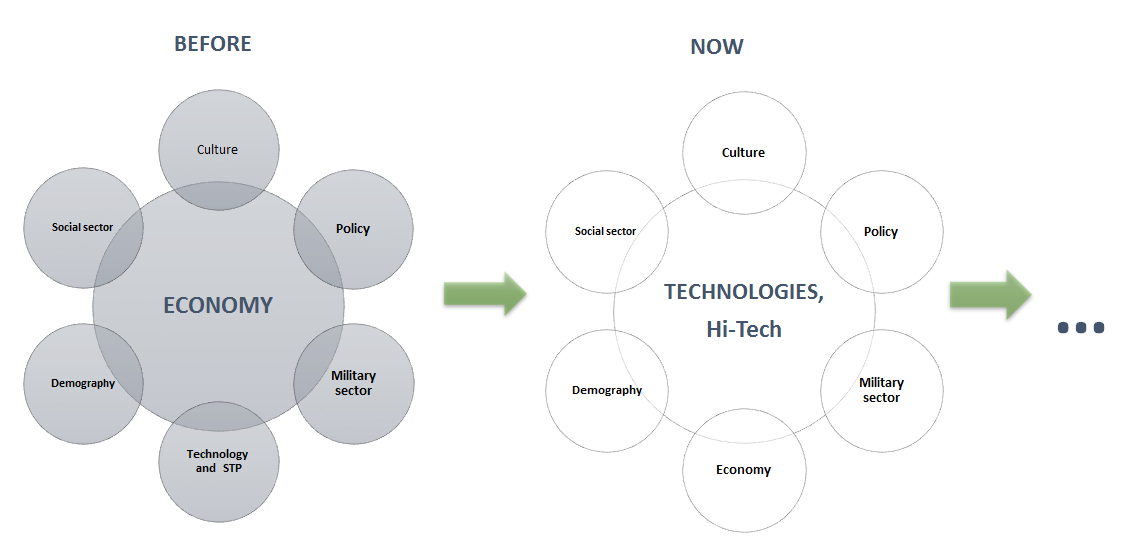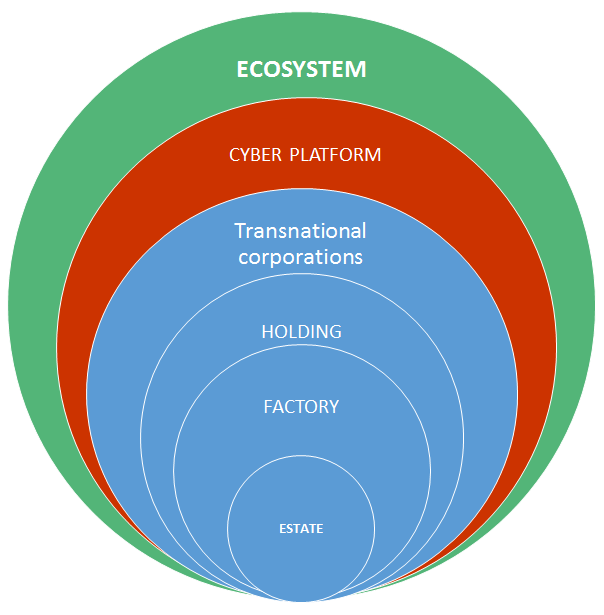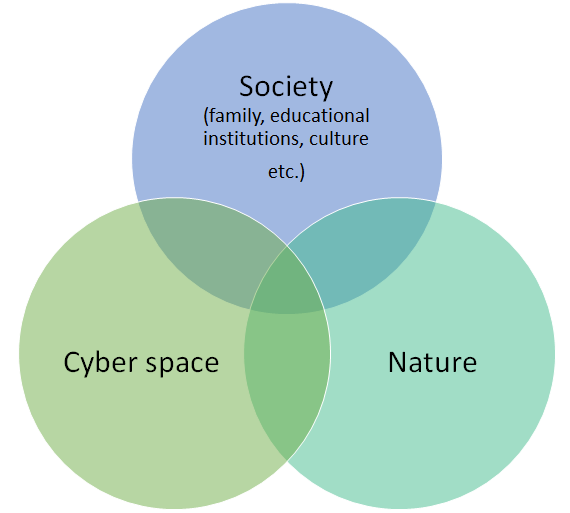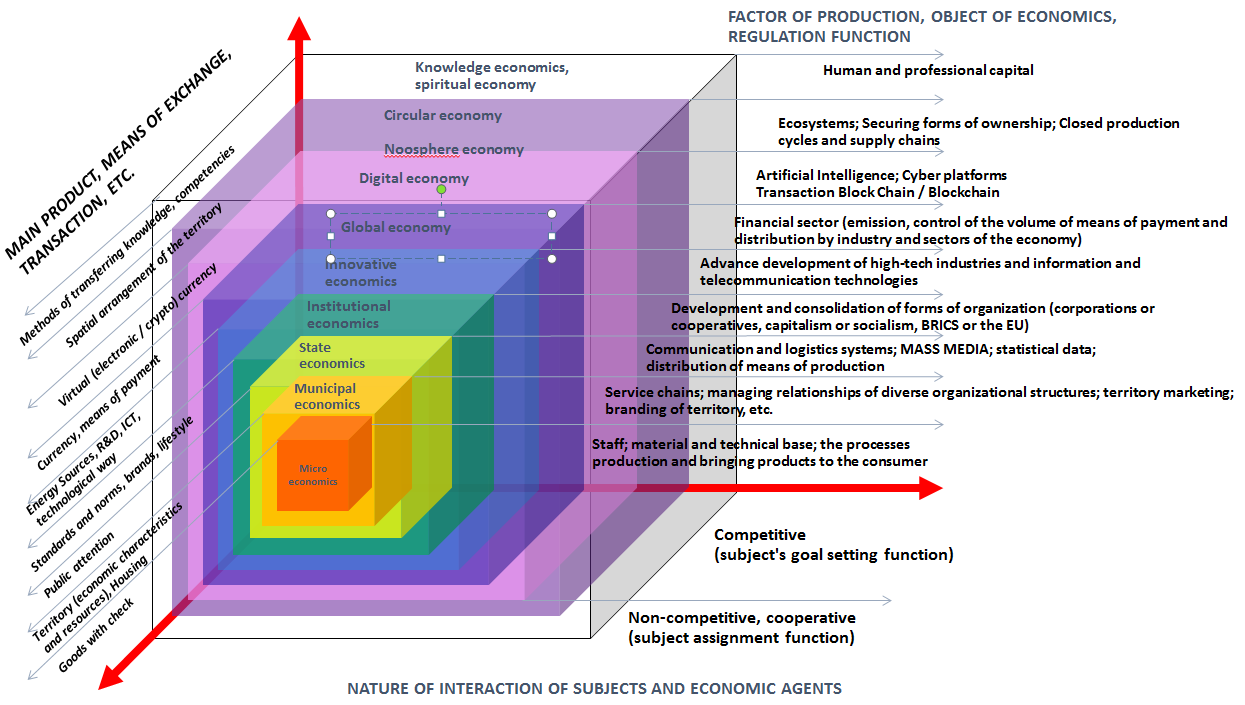Abstract
The article is devoted to the study of modern problems of multidimensional interpretation of economic parameters (processes, phenomena), the development of cooperative strategies and economic activity of the population in the context of digitalization of the economy. Studying the problem of accelerating updating of the dominant technologies (digital revolution, Hi-Tech, High-Hume), the influence of the spatial arrangement of the living environment on its socio-ecological, productive and consumer (marketing) determination is determined. The development of a model of spatial arrangement of the populated environment presents a leading prospect for the subsequent economic and technological development of countries, as well as for the development of new types of goods that will form a new way of life for the population. When used, human consciousness (attention, intelligence) is also included in the economic turnover as a special product of labor activity in the field of culture, education and science. The recognition of the priority of high humanitarian technologies in the spatial arrangement of territories provides significant potential for economic development by overcoming the linear development of industries, improving the forms of cooperative interaction of economic agents, cognitive technologies and ways of materializing knowledge. In matters of international economic relations, models of spatial arrangement of the territory will play a key role, because they will form the basis for macro-projects of the future, which will not represent the relations of countries with each other, but will offer a space for the life of each individual.
Keywords: Cognitive technologiesdigital economyhumanitarian technologiesmultidimensional economicsspatial arrangement
Introduction
In modern society, the struggle of macro-projects is increasingly becoming apparent, the effectiveness of which is determined mainly by the degree of mass participation of the population of various countries. The readiness of states to this process manifests itself in different ways. Some integrate into digitalization, others into trade and economic unions, some build up armed capabilities, and reform education and science. For some this happens as preparation for the future and its programming, for others as a forced adaptation. Participants in political and foreign economic relations are required to more and more comprehensively analyze the experience of participation in macro projects, and determine the acceptable degree of involvement or influence of their countries on these projects.
Until recently, the possibilities for countries to participate in macro-projects were largely determined by the capabilities of the economic model prevailing on their territory. However, this situation in some countries is determined more by an adaptive approach to vertical integration processes than by a proactive one. The orientation of social relations on a globalization scale was previously built primarily on the economic sector, now the economy itself has become more responsive to non-economic factors, mainly political, technological, demographic and ethical (values, morality, etc.). A key role in managing integration processes today is assigned to breakthroughs in the field of high digital information and communication technologies (see Figure

Life in the digital age seems restless to many researchers. This problem is clearly manifested in the framework of the model of techno-humanitarian balance developed by the Russian scientist Nazaretyan (2004) describing the relationship between human activity, man-made crises, social and historical progress and disasters. Based on this model, it can be observed that “the growth of technological power, on the one hand, increases the external sustainability of society, and on the other hand, strengthens the feeling of omnipotence and impunity, which as a result leads society to a crisis”. Social violence is increasing, the natural environment is being destroyed, and the internal sustainability of society is decreasing (Nazaretyan, 2004). The total digitalization of public spheres has exacerbated the phenomenon of “fluidity of reality”. The content and context of the basic categories in economics, law, politics, etc., is changing, habitual reality is changing.
Digitalization leads to the formation of the conglomerate of data, which increases the likelihood of economic entities fulfilling someone else's agenda: goals and means can be imposed from without. Now, each business entity, regardless of the scale of activity, is involved in vertical integration processes, as a special way of coordinating production participants and selling finished products, often without a compromise basis
Digital centralization on a global scale creates additional risks for many countries associated with millions of hectares of uncultivated land, deforestation and the disappearance of human settlements. Therefore, society is increasingly in need of a comprehensive assessment and scientific examination of the influence of factors of digitalization of public spheres and the accelerating update of dominant technologies (Hi-Tech revolution) on the state of the country's human capital (its relevance in the international division of labor, etc.).
At the same time, costs per person - in accounting, are still included in costs, cost, expenses. The lower the cost per person, the more effective is the management of the economy (Nikitenko, 2014).
Problem Statement
In the context of transformations and attempts to master the “digital” economy by leading countries, they offer their experience in the framework of state programs, presented in Table
However, even such measures are not able to ensure the orderliness and orderliness of overdue reforms. For most countries, IT innovations are often ahead of their thinking, and forecasting the possible consequences of global trends is inferior to their growing transformations.
The introduction of innovations on the scale of the whole of humanity forms new mechanisms for managing public relations, and contradictions are growing between political and productive forces that lead to the aggravation of economic conflicts, up to the institutional level of interaction. Therefore, each country today needs to offer the world public its own understandable and perceived macro-project for the safe development of society, and act accordingly. Any other way is an aggravation of the struggle of meanings, ideas, technologies, military weapons, etc. This circumstance gradually leads to the emergence of such forms of organizations that will be able to most fully concentrate the set of tools for managing social systems: chronological, ideological, economic, military, and others inherent in each culture (Wheeler, 2002).
Economic entities are faced with the task of developing integrated models for the development and development of such a technological structure that allows them to overcome the risks of digital colonization. To a greater extent, the construction of such models is associated with overcoming the linear development of economic sectors, leading to the improvement of the forms of cooperative interaction of economic agents and methods of materializing knowledge (see Figure

The development of social systems has always been accompanied by the emergence of larger-scale forms of organizational interaction, up to the level of intercultural cooperation. Ensuring the consistency of economic relations in the context of the diversity of cultural spaces (multipolarity) and overcoming the linear development of economic sectors puts business entities in a multidimensional interpretation of economic parameters, processes and phenomena. Therefore, the need to develop and search for tools to formalize the model of multidimensional economic interdependencies and interactions of economic entities will only grow. The organizations of the future are faced with the overwhelming tasks of determining the economic efficiency of the integral properties of ecosystems and the training of personnel able to master these advantages (Gnezdova, Khoroshavina, Lebedeva, Balynin, & Sanginova, 2019).
Research Questions
As a rule, high technology is associated with high technology and the strengthening of the processes of commercialization of science. Among the high technologies it is customary to include nanotechnologies, IT, biotechnologies, microelectronic technologies, space technologies, etc. However, their direct implementation on the market is determined to a greater extent by breakthroughs in the field of humanitarian technologies (social engineering, High-Hume, etc.), which subsequently affect the position of countries in the international distribution of spiritual and material goods.
Humanitarian technologies are a kind of sociocultural mechanisms in which new methods of activity are produced based on the practical use of knowledge about a person to create and develop conditions for free and comprehensive development. They are designed on the basis of a systematic and active approach to the application of the results of human activity, thinking, knowledge and education here become their main and central link.
Hi-Hume technologies are the result of the convergence of social and information technologies aimed at processing information, as well as the latest achievements in the field of psychology, cognitive technologies, neurophysiology, ethology and other sciences. Moreover, they can carry not only professional and personal growth promotion, but also mass or point interactions of a manipulative nature with the human consciousness and subconscious (Rachwał, 2011).
In the event that formalized cognitive technologies break away from the practice of living natural knowledge, Hi-Hume technologies have serious limitations in the development of human capital in any country. In such circumstances, society can be represented by contradictions associated with archaism, atomization and inequality. The only working tool for overcoming the described dead end branch of digitalization, rationalization and manipulation of social relations is the sphere of spatial arrangement of the populated environment.
The development of a model of spatial arrangement of populated territories is of high cognitive and communication value in the processes of formation and development of human capital. The priorities of spatial arrangement of territories in Hi-Hume technologies affecting the socio-ecological, demographic, productive and consumer (marketing) determination of the living environment should be:
developed social infrastructure and increasing the capacity of the domestic market;
building intellectual infrastructure of territories;
assistance to cooperative strategies of interaction between business entities;
the formation of the cognitive environment of Man for the development of the potential of social development and reproduction;
increasing the level of development of human capital, innovative potential and entrepreneurial activity of the population.
The basic condition for the introduction of high humanitarian technologies through the spatial arrangement is a single learning space, which is understood as the principle of the integrity of self-development, self-organization and adaptation of general and professional education in real life conditions in specific territories.
In other words, an integrated educational space is not so much the same requirements for the professional training of the teaching staff and remote forms of education, but rather the building of a living environment in which everything that happens in the student’s environment is taught. Such a task assumes the unity of the three components (Figure

Purpose of the Study
The aim of the study, as a result of the problems posed, is to search and identify tools to formalize a model of economic relations that allows the most comprehensive combination of the multidimensional interpretation of economic facts and overcoming the risks of human capital development associated with the digitalization of the economy.
Research Methods
The presence of differences in economic activity in the areas of management, levels of socialization and technical equipment of various industries, necessitates the use of various forms of ownership, organizational and legal forms of management, production, management and labor motivation. These tasks are formalized only from the level of construction of economic models.
The economic model can be formalized in the form: . In other words, the economic model ( ) is determined by its properties and a set of processes , where there are such properties. This means that the economic model cannot be defined in terms of a single characteristic. Variable may also appear to be some kind of economic process, which may depend on a number of factors, such as: – forms of ownership; – freedom of activity of process participants; – regulatory functions of power; – technological way.
If we write the general equation of the economic process, it will have the following form . Parameters and are extremely poorly quantifiable and therefore can not be taken into account in the general equation, at this stage of the development of science. Then, the equation takes the form: .
For example, can take three forms: – state / municipal property; – private property (corporate and individual); is civilian property. In its final form, the equation of the economic process will look like this: .
Formalization of the economic model is too difficult when it includes parameters that are not amenable to unambiguous (linear) measurement, assessment and predictability. However, in a voluminous (multidimensional) section, free, unpredictable parameters may well be adjustable from a larger scale of coordination of economic relations. Therefore, the formalization of the processes of vertical integration of the economic model is often based on a certain attribute (aspect), highlighting a somewhat global criterion to which the observed parameters correspond. Vertical formalization of the economic process is very difficult, but necessary to take into account the multidimensionality of economic relations and to identify the contribution of economic agents in the processes of economic integration.
Ultimately, the economic model can be represented in the form of a multidimensional matrix with its own set of economic processes and adjustable parameters (see Figure

The inclusion of a larger set of agreed parameters of different levels of economic relations allows us not only to master new tools for regulating economic systems and models, but also to produce products with the greatest capacity and content of goods, which, in turn, receives the support of a larger number of management entities at the level of public institutions and political forces and states. The scale of cooperation of economic agents in the modern world is expressed in the capacity of manufactured products (Grishakina & Zaretskaya, 2018).
In other words, in the modern economy, the manufacturer that sells and offers a product that has greater dimensionality, functionality and comprehensiveness with related pre-sale and after-sales services is competitive.
Findings
The multidimensionality of the economy is manifested in the fact that each distinguished subsystem has its own criterion for the effectiveness of the interaction of economic entities, which is a specific variety of production factors. The main and most capacious of such factors of production, which contains all the multidimensionality of economic activity, is the sphere of knowledge, which is at the same time a product of spiritual mental labor.
A multidimensional economy is a model of economic relations that ensures the effectiveness of the process of materialization (materialization) of knowledge, bringing it to the state of the product and implementation at the household level of life.
A multidimensional model is presented (see Figure

The knowledge brought to the stage of the product acquires the property of a universal transaction. Analyzing attempts to measure the knowledge economy, we come to the conclusion that the multifaceted nature of the phenomenon of “knowledge-based economy” does not lend itself to mathematical rigor and the coverage of all aspects of forecasting, analyzing and evaluating its formation on a global scale. The methodological principles for solving this research problem are a combination of the determinism of socio-economic phenomena and the variability of the behavior of economic agents, which takes its concrete historical form under the influence of a certain technological and institutional environment.
The development of human capital at the scale of countries and their unions lies mainly in solving the main problems and challenges of spatial arrangement, building the intellectual infrastructure of the territories. A special role in this development of cognitive technologies is assigned to the emergence of a circular (noospheric) economy, which is characterized by a closed cycle of reproduction of goods. A distinctive feature of the noosphere economy is the growth of the knowledge-intensiveness of GDP and the implementation as a priority human need – the continuity of education based on the growth of its science-intensiveness. Continuity of education on the basis of the methodology for the development of completely new planetary knowledge, increase of their high technology knowledge provides the growth of professionalism and the quality of labor resources and the possibility of long-term growth of the organic structure of production, and, consequently, increase its intensification, professionalism and efficiency on the basis of scientific and technical progress.
Competition in the context of the noosphere economy is becoming a factor in limiting the development of the economy, motivation and improving product quality. Many natural factors are considered by competing entities as restrictive due to their orientation towards a short-term local optimum, which does not allow one to master the advantages of the integral properties of ecosystems. The noosphere approach in matters of the concept of ownership (private / public) provides ownership to that entity, which in its decisions and actions relies on the integral properties of ecosystems and takes into account the factor of influence on the evolutionary processes of the Planet. All other decisions will sooner or later lead to loss of property (Nuttunen, & Popova, 2016).
From the perspective of the noosphere economy for the implementation of high humanitarian technologies, the optimal structure of the territory's GDP should be determined on the basis of the Fibonacci rule:
20% of GDP is the share of material production (GOODS, Hi-Tech).
30% of GDP – the service sector (SERVICES, Hi-Hume).
50% of GDP is the knowledge based sector (KNOWLEDGE, INFORMATION, DATA, SCIENCE, EDUCATION, CULTURE).
This approach boils down to the fact that the population of any administrative-territorial unit must at each stage of its development comprehend their experience and express it in texts, art, creativity, technology, etc. The process of knowledge production is not purely economic. Knowledge in the knowledge economy is more a means of production than a commodity, and this requires a more careful attitude to the mechanisms of intellectual property and copyright, in which the owner of knowledge commercializes the methods of transferring knowledge, rather than imposing a ban on their use and application.
As can be seen from the presented model, the highest and most ambitious form of economic activity within the framework of the socio-economic system is the process of materialization (materialization) and the transfer of knowledge, the reproduction of human capital, and the modern market is turning into a system that operates on the basis of the exchange of knowledge and their mutual evaluation (Nuttunen, 2018).
Conclusion
The model of a multidimensional economy allows entities to harness the potential of the economic space while avoiding the juxtaposition and isolation of economic models, which gives incomparably greater opportunities for territorial development. Therefore, the main condition for ensuring stability in the processes of vertical integration is the training of a personnel corps interacting on cooperative interaction strategies in various fields of activity. Such preparation is increasingly beyond the scope of economic knowledge, sometimes these are problems of cultural and ethical nature (values, morality, etc.). In this case, special attention should be paid to the qualifications of the consumer, the education of his selectivity, awareness, etc. through the use of cognitive technologies in the information space. This allows you to develop mechanisms to ensure the public (public and communication) space of the living environment that accompanies the development of industrial and consumer cooperation in the territories, increasing accessibility for small and medium producers of sales markets.
Recognizing the priority of high humanitarian technologies in the spatial arrangement of territories provides a significant reserve in the development of the economy by overcoming the linear development of industries, improving the forms of cooperative interaction of economic agents, cognitive technologies and ways of materializing knowledge. No activity of economic unions is justified if it does not implement breakthrough humanitarian technologies.
A key object in managing the development of human capital is a spatial cognitive environment. In light of this, only a society expects a qualitative breakthrough in which macro-projects of the future do not represent the relations of countries with each other, but offer a space for the life and development of each individual, where any territory should become a scientific and educational training ground generating and transmitting new knowledge.
References
- Gnezdova, Yu. V., Khoroshavina, N. S., Lebedeva, N. E., Balynin, I. V., & Sanginova, L. D. (2019). The impact of the industry digitization on the economic development of the country. Amazonia Investiga. 21(8), 633-643.
- Grishakina, N. I., & Zaretskaya, A. S. (2018). Theoretical aspects of simulation. In T. Yu. Chernysheva (Ed.), Modern decision-making technologies in the digital economy: Proceedings of the All-Russian Scientific and Practical Conference of students, graduate students and young scientists, (pp. 16-18). Tomsk, Russian Federation: TPU. [in Russ.].
- Luthans, F., Luthans, K. W., & Luthans, B. C. (2004). Positive psychological capital: beyond human and social capital. Business Horizons, 1, 45.
- Nazaretyan, A. P. (2004). Anthropogenic crises: the hypothesis of techno-humanitarian balance. Bulletin of the Russian Academy of Sciences, 4(74), 320-330.
- Nikitenko, P. G. (2014). International noospheric worldview model of creative sustainable socio-economic development. In A. I. Subetto, & V. A. Shamakhova (Eds.), National and civilizational foundations of the Russian world: Proceeding of VII international scientific-practical conference (pp. 18-25). St. Petersburg: Asterion. [in Russ.].
- Nuttunen, P. A. (2018). Multidimensionality as a principle of systematic economic relations in the process of spatial arrangement of rural territories. News of St. Petersburg State Agrarian University, 3(52), 158-164.
- Nuttunen, P. A., & Popova, A. L. (2016). Characteristics of human resources that determine the development of local self-government in rural areas. Bulletin of St. Petersburg State Agrarian University, 43, 225-230.
- Rachwał, T. (2011). Transformations of the employment structure as an expression of the transformation of polish industry against the background of the European Union. Bulletin of Geography. Socio-economic Series, 15, 5-25.
- Wheeler, S. M. (2002). The new regionalism: key characteristics of an emerging movement, American Planning Association. Journal of the American Planning Association, 3(68), 267.
Copyright information

This work is licensed under a Creative Commons Attribution-NonCommercial-NoDerivatives 4.0 International License.
About this article
Publication Date
31 December 2019
Article Doi
eBook ISBN
978-1-80296-076-1
Publisher
Future Academy
Volume
77
Print ISBN (optional)
-
Edition Number
1st Edition
Pages
1-1056
Subjects
Industry, industrial studies, project management, sustainability, business, innovation
Cite this article as:
Zaretskaya*, A. S., & Nuttunen, P. A. (2019). Spatial Arrangement Of The Territory In The Context Of Multidimensional Economic Reality. In I. O. Petrovna (Ed.), Project Management in the Regions of Russia, vol 77. European Proceedings of Social and Behavioural Sciences (pp. 574-583). Future Academy. https://doi.org/10.15405/epsbs.2019.12.05.71
